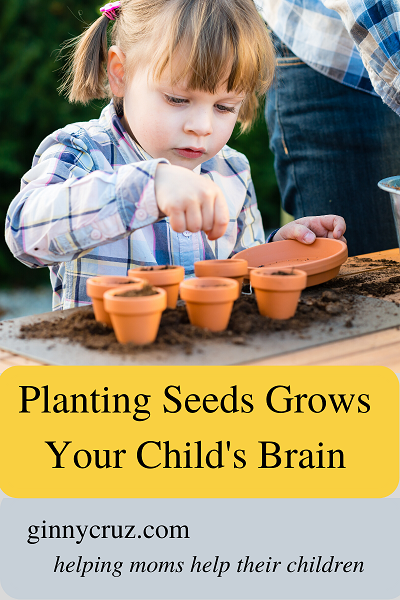Planting Seeds Grows Your Child’s Brain
Today’s young minds spend a lot of time playing in virtual worlds created for them on television, tablets, or smartphones. Yes, they could watch a show where a child their age learns how to plant seeds. They can sing a little song about it, and watch the new plant spring up in record time. But their brains miss a lot of rich, deep learning if this is the only way they experience planting seeds.
Let’s learn another way. Pretend with me for a moment.
“Grace, get your boots on,” you call as you pull on your new pink ones. “We’re going to plant some seeds outside.”
“I don’t want to!” Grace wails. “My show’s coming on and it’s cold outside.”
“No. We need to start the tomato seeds so we’ll have tomatoes for our salads in a few months.” You shrug into your windbreaker. “Besides, the fresh air is good for you.”
Grace eventually makes her way over to the back door and plops down on the floor. “I can’t put my new boots on. They’re too tight.”
“Here, I’ll help.” You crouch down and help pull on her yellow boots and assist her with zipping her coat. “There now. Those boots are going to love exploring the back yard now that the snow is melted.”
With a little help, Grace opens the door. Holding hands, you descend the steps and head for the shed.
“What are we planting again?” Grace asks as she pulls away and splashes through a nearby puddle.
“Cherry tomatoes.” You unlock the door and flip the light switch. “There. Now we can see what we’re doing.”
“Cherry tomatoes? Do those taste like cherries or tomatoes?” Grace inquires as she stomps up the ramp into the shed. She points to a shadow on the wall. “Is that a bat?”
You open the bag of potting soil and locate the garden trowel on the workbench. “My my, you’re full of questions. No, that’s not a bat; it’s a shadow. Cherry tomatoes taste like tomatoes, not cherries. They’re those little juicy ones you enjoy on your salad.”
“I love those.” Grace peers into the bag of dirt. “Where are they?”
“We have to plant the seeds first, silly. Get me that empty egg container.” You point at the bench. “We’re doing to put soil in that and then plant the seeds in the soil.”
Grace tiptoes up and snatches the egg carton. “Can I do the dirt?”
“That’s the idea,” you say as she returns. “I’ll hold the carton and you take the trowel and fill it with dirt. Then we’ll plant the tomato seeds.”
Grace digs into the bag and, after a few attempts, eventually gets the idea.
“Good job! Now use your hand and level the dirt out so it’s even in each one.” You show her how.
“Now use one finger and poke a small hole in each cup.” You demonstrate.
After sprinkling some seeds into your palm, you lower it so Gracie can reach them. “Now pick up two or three seeds and drop them into each hole.”
After a few mistakes, Grace completes the task. “This is fun!” she smiles.
“Next, gently push the dirt over the seeds and then we’ll water them.”
“I want to water,” Grace says eagerly as she covers the seeds and wipes her dirty hands on her jeans.
You giggle. “After we give the seeds a little drink, we’re going to have to wash up in the mudroom!”
During this simple activity, here’s what transpired:
She practiced these gross motor skills:
- Walking
- Tiptoeing
- Stomping
She worked on the fine motor skills of:
- Pulling on boots and coat
- Opening doors
- Digging with a trowel and hands
- Poking holes for seeds
- Watering the seeds
She felt these sensory experiences:
- Cool air, wet water, grainy soil, tiny seeds
- The smells of soil, water, dusty shed, gasoline from the lawnmower, fertilizer
- The heaviness of dirt and the watering can
She engaged in these speech & language skills:
- Back and forth conversation
- Over 200 words were exchanged, including nouns, verbs, adjectives, emotions, requests, protests, etc.
She enjoyed the social moments of:
- Togetherness
- Making a memory
She learned the life skills of:
- Filling a container
- Using a trowel
- Planting a seed
She gained a deeper appreciation and understanding of:
- Her environment
- Where her food comes from
- How difficult it is to grow food
During this entire activity, her brain’s neural connections were on rapid-fire as memories were made, calculations on force and precision occurred, and constant language was used. All areas of her body and brain were engaged. Using all of her senses and moving her body is how her brain grows strong. These types of experiences create a strong base of knowledge on which to add more abstract learning, such as identifying letters or reading, which occur when she’s older.
The next time she sees a picture in a book of a little girl planting a plant, she’ll recall how the dirt felt and smelled, how tiny the seeds were, and how difficult it was to drop them into the hole. When she eats cherry tomatoes on her salad, she’ll recall how the seed looked and how it all started.
She’ll have none of these memories or experiences if she watched a character on a screen dig a hole, plop in a seed, water it, and watch it sprout like magic. It looks easy there but she’s smarter now knowing that growing cherry tomatoes from seed is difficult—it takes time and careful attention.
This is a simple example of why real-world activities are better choices for your child than virtual entertainment or engagement. She would have learned almost none of the above skills on a screen.
What seeds are you helping your child plant this spring?
(Photo from Adobe Stock)

